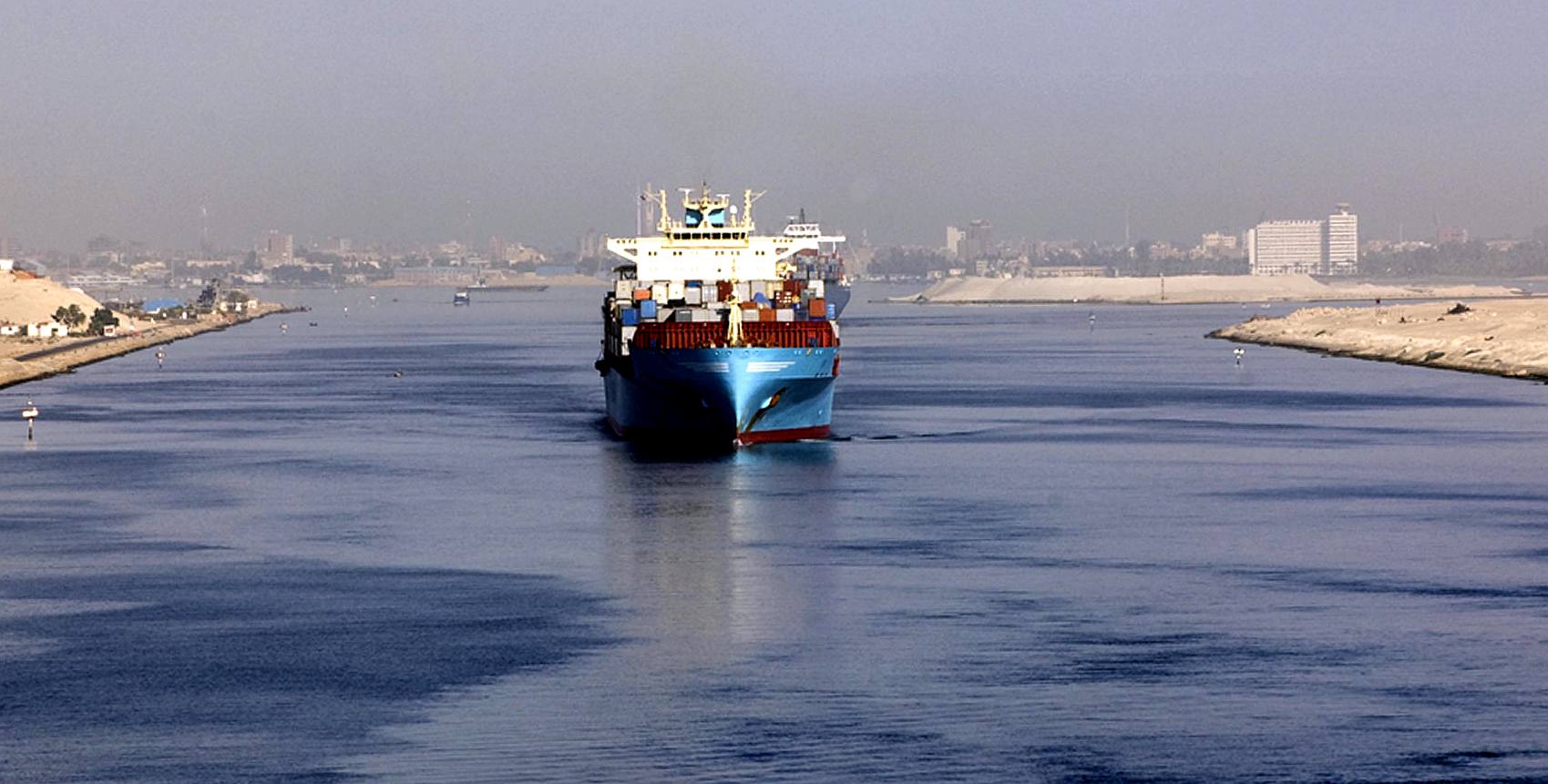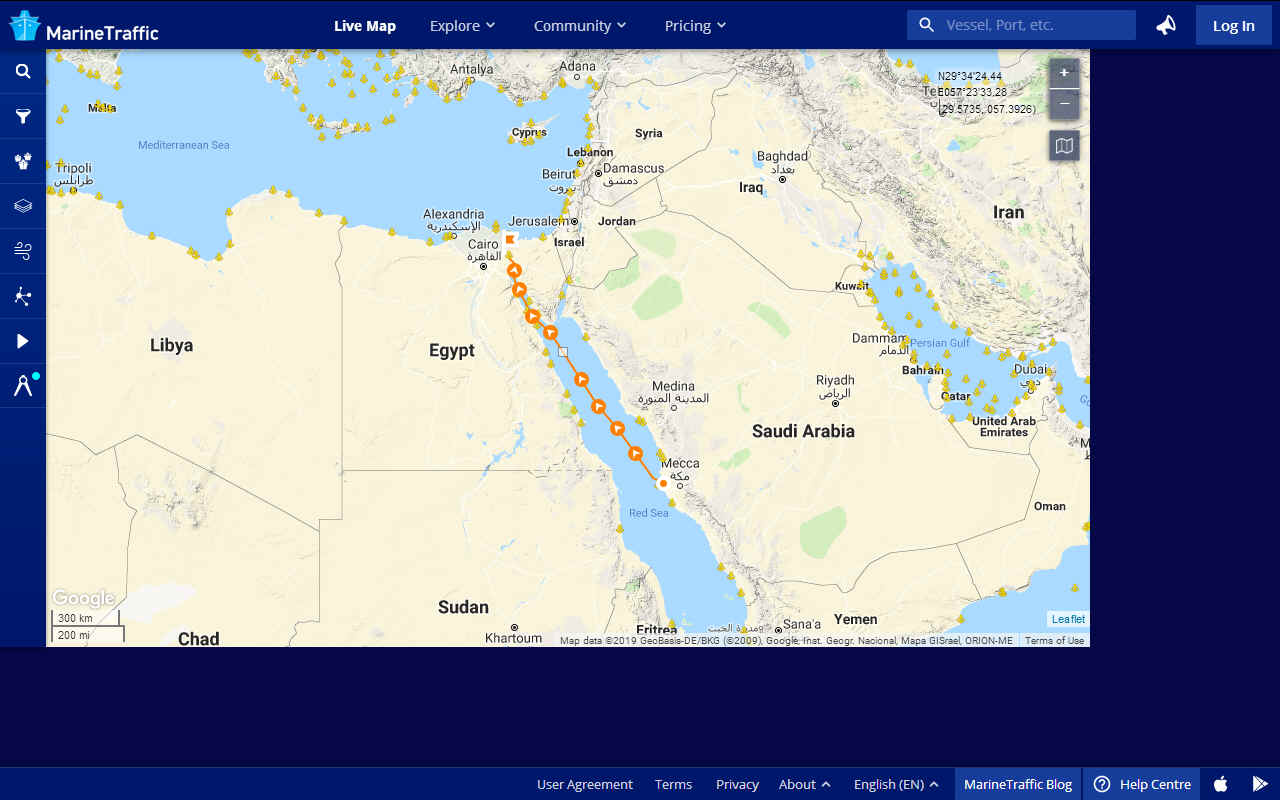|

The
Suez
Canal is a sea-level waterway in
Egypt, connecting the Mediterranean Sea to the Red Sea through the Isthmus of Suez. Constructed by the Suez Canal Company between 1859 and 1869, it was officially opened on 17 November 1869. The canal offers watercraft a shorter journey between the North
Atlantic and northern
Indian
Ocean via the Mediterranean and Red Seas by avoiding the South Atlantic and southern Indian Oceans, reducing the journey by approximately 6,000 kilometres
When first opened in 1869, the canal consisted of a channel barely 26 feet (8 metres) deep, 72 feet (22 metres) wide at the bottom, and 200 to 300 feet (61 to 91 metres) wide at the surface. To allow ships to pass each other, passing bays were built every 5 to 6 miles (8 to 10 km). Construction involved the excavation and dredging of 97 million cubic yards (74 million cubic metres) of sediments. Between 1870 and 1884 some 3,000 groundings of ships occurred because of the narrowness and tortuousness of the channel. Major improvements began in 1876, and, after successive widenings and deepenings, the canal by the 1960s had a minimum width of 179 feet (55 metres) at a depth of 33 feet (10 metres) along its banks and a channel depth of 40 feet (12 metres) at low tide.
In 2008, 21,415 vessels passed through the canal and the receipts totaled $5.381 billion, with an average cost per ship of $251,000.
Ports along the Suez canal are not hydrogen ready at time of
writing. Clean fleet operators will have to seek alternative
handling facilities to comply with the IMO's
2040 target.
|
LEG
|
NAUTICAL
MILES
|
BUNKERING
|
WAYPOINT
|
SUNSHINE
DAYS
|
|
- |
- |
- |
- |
- |
|
|
-
|
-
|
-
|
-
|
|
-
|
-
|
FILL
UP
|
Gibraltar
|
00.00
|
|
1
|
729
|
-
|
Tenerife,
Canary Islands
|
1.90
|
|
2
|
3,154
|
-
|
Trinidad,
Port of Spain
|
8.21
|
|
3
|
1,182
|
1
|
Panama
City
|
3.00
|
|
4
|
970
|
-
|
Galapagos
|
2.45
|
|
5
|
3,640
|
-
|
Tahiti
|
9.48
|
|
6
|
1,423
|
-
|
Tonga,
Nukualofa
|
3.71
|
|
7
|
410
|
-
|
Fiji,
Suva
|
1.07
|
|
8
|
1,886
|
1
|
Port
Moresby PNG
|
4.91
|
|
9
|
340
|
-
|
Thursday
Island, Cape York
|
0.88
|
|
10
|
724
|
-
|
Darwin
|
1.89
|
|
11
|
1,572
|
-
|
Jakarta,
Indonesia
|
4.09
|
|
12
|
1,881
|
-
|
Colombo,
Sri Lanka
|
4.90
|
|
13
|
2,109
|
1
|
Aden,
Yemen
|
5.49
|
|
14
|
698
|
-
|
Jeddah,
Saudi Arabia
|
1.82
|
|
15
|
670
|
-
|
Port
Said, Egypt
|
1.75
|
|
16
|
1,111
|
-
|
Palermo,
Sicily
|
2.89
|
|
17
|
170
|
-
|
Naples,
Italy
|
0.44
|
|
18
|
940
|
|
Gibraltar
|
2.45
|
|
- |
- |
- |
- |
- |
|
- |
23,609
|
-
|
RUNTIME
DAYS @ 12.5kts
|
78.70
|
|
- |
-
|
(ADD
3 DAYS)
|
RUNTIME
DAYS @ 13kts
|
75.67
|
|
- |
- |
- |
- |
- |
|
-
|
-
|
(ADD
4 DAYS) |
14
KNOTS AVE INC
|
70.26
|
|
- |
- |
- |
AT
15 KNOTS AVE
|
65.58
|
|
-
|
-
|
- |
AT
16 KNOTS AVE
|
61.48
|

15TH
LEG - At
a speed of 13 knots the fifteenth leg of the hydrogen
powered zero
carbon voyage
would take just over two days to complete, free of emissions.
The demonstration of ZEWT
technology in action, could help speed up the transition to
non polluting waterborne
transport. These projections are only a guide. Many of the
ports of call could be bypassed completely to give us a
shorter passage. Very few international destinations are
hydrogen ready, meaning that fleet operators may need to find
alternative handling facilities.
|
LEG
|
NAUTICAL
MILES
|
TIME
IN PORT
|
WAYPOINT
|
SUNSHINE
DAYS
|
|
-
|
-
|
-
|
-
|
-
|
|
|
-
|
-
|
Monaco
|
0.00
|
|
1
|
784
|
2
|
Gibraltar
|
4.67
|
|
2
|
729
|
2
|
Tenerife,
Canary Islands
|
4.34
|
|
3
|
3,154
|
2
|
Trinidad,
Port of Spain
|
18.77
|
|
4
|
1,182
|
2
|
Panama
City
|
7.04
|
|
5
|
970
|
2
|
Galapagos
|
5.77
|
|
6
|
3,640
|
2
|
Tahiti
|
21.67
|
|
7
|
1,423
|
2
|
Tonga,
Nukualofa
|
8.47
|
|
8
|
410
|
2
|
Fiji,
Suva
|
2.44
|
|
9
|
1,886
|
2
|
Port
Moresby PNG
|
11.23
|
|
10
|
340
|
2
|
Thursday
Island, Cape York
|
2.02
|
|
11
|
724
|
2
|
Darwin
|
4.31
|
|
12
|
1,572
|
2
|
Jakarta,
Indonesia
|
9.36
|
|
13
|
1,881
|
2
|
Colombo,
Sri Lanka
|
11.20
|
|
14
|
2,109
|
2
|
Aden,
Yemen
|
12.55
|
|
15
|
698
|
2
|
Jeddah,
Saudi Arabia
|
4.15
|
|
16
|
670
|
2
|
Port
Said, Egypt
|
3.99
|
|
17
|
1,111
|
2
|
Palermo,
Sicily
|
6.61
|
|
18
|
170
|
2
|
Naples,
Italy
|
1.01
|
|
19
|
393
|
|
Monaco
|
2.34
|
|
-
|
-
|
-
|
-
|
-
|
|
-
|
23,846
|
36
|
RUNTIME
DAYS @ 7kts
|
141.94
|
|
-
|
-
|
-
|
-
|
-
|
|
+
10% service
|
=
156.13 Days
|
-
|
7
KNOTS AVE INC PORT & %
|
192.13
|
|
-&
maintenance
|
-
|
-
|
AT
6 KNOTS AVE
|
224.16
|
|
-
|
-
|
-
|
AT
5 KNOTS AVE
|
268.99
|
SOLAR
POWERED TRANSIT
EXAMPLES - The above table illustrates one of the most likely
climate/ocean awareness expedition routes that could be undertaken by the
Elizabeth Swan, showing the time elapsed in days for 7 knots average
cruising speed, including times for 5 and 6 knot averages - allowing for
10% downtime and 36 days in ports. Hence, although the objective is to
reduce the current solar
circumnavigation
record from 584 days, the event in not an outright non-stop yacht
competition in the offshore racing sense.
|
LEG
|
NAUTICAL
MILES
|
BUNKERING
|
WAYPOINT
|
SUNSHINE
DAYS
|
|
-
|
-
|
-
|
-
|
-
|
|
|
-
|
-
|
-
|
-
|
|
-
|
-
|
FILL
UP
|
Gibraltar
|
00.00
|
|
1
|
729
|
-
|
Tenerife,
Canary Islands
|
1.90
|
|
2
|
3,154
|
-
|
Trinidad,
Port of Spain
|
8.21
|
|
3
|
1,182
|
1
|
Panama
City
|
3.00
|
|
4
|
970
|
-
|
Galapagos
|
2.45
|
|
5
|
3,640
|
-
|
Tahiti
|
9.48
|
|
6
|
1,423
|
-
|
Tonga,
Nukualofa
|
3.71
|
|
7
|
410
|
-
|
Fiji,
Suva
|
1.07
|
|
8
|
1,886
|
1
|
Port
Moresby PNG
|
4.91
|
|
9
|
340
|
-
|
Thursday
Island, Cape York
|
0.88
|
|
10
|
724
|
-
|
Darwin
|
1.89
|
|
11
|
1,572
|
-
|
Jakarta,
Indonesia
|
4.09
|
|
12
|
1,881
|
-
|
Colombo,
Sri Lanka
|
4.90
|
|
13
|
2,109
|
1
|
Aden,
Yemen
|
5.49
|
|
14
|
698
|
-
|
Jeddah,
Saudi Arabia
|
1.82
|
|
15
|
670
|
-
|
Port
Said, Egypt
|
1.75
|
|
16
|
1,111
|
-
|
Palermo,
Sicily
|
2.89
|
|
17
|
170
|
-
|
Naples,
Italy
|
0.44
|
|
18
|
940
|
|
Gibraltar
|
2.45
|
|
-
|
-
|
-
|
-
|
-
|
|
-
|
23,609
|
-
|
RUNTIME
DAYS @ 12.5kts
|
78.70
|
|
-
|
-
|
(ADD
3 DAYS)
|
RUNTIME
DAYS @ 13kts
|
75.67
|
|
-
|
-
|
-
|
-
|
-
|
|
-
|
-
|
(ADD
4 DAYS)
|
14
KNOTS AVE INC
|
70.26
|
|
-
|
-
|
-
|
AT
15 KNOTS AVE
|
65.58
|
|
-
|
-
|
-
|
AT
16 KNOTS AVE
|
61.48
|
|
|

A
RACE AGAINST THE CLIMATE CLOCK: The
climate clock is ticking faster, speeding up global
warming. Solar power is a proven means of traversing the oceans, but it
is
too slow for cargo transport as we write. But introduce hydrogen into
the equation and we can manage up to 4000nm
on hydrogen tanks alone. Using LH2, it might be possible to circumnavigate
the globe on one tank full - and using solar in combination, travel Around
The World In 80
days. Without hydrogen
bunkering at ports and harbours it is more of a logistical
challenge. This is a problem for port
authorities and operators all over the globe, a topic for COP26
and similar events - as the world continues to fry on fossil fuels.
http://jules-verne.org/
http://jules-verne.org/
Please use our
A-Z INDEX to
navigate this site
This website is Copyright ©
2021 Jameson Hunter Ltd, an equal opportunities company. This website is
carbon friendly, using less energy to load on average per page via
simplicity & picture optimization. The same may not apply to third party
links.
|


